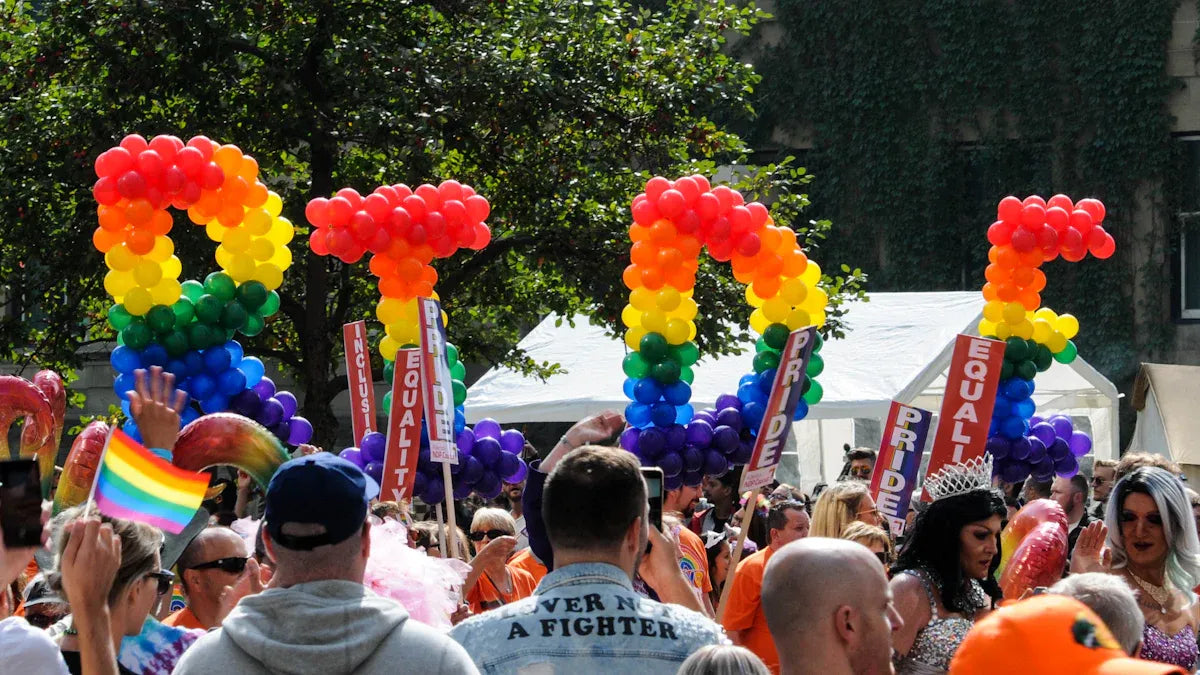
Ways People Around the World Mark Pride Month
You might feel amazed by how people across the globe celebrate Pride Month. In 2021, at least 107 countries joined in Pride Month celebrations, showing how far the community’s spirit reaches. Some cities burst with colorful parades and huge events, while others keep things quieter or face real challenges. Take a look at this chart—it shows just how much people search for different Pride events and symbols every month:
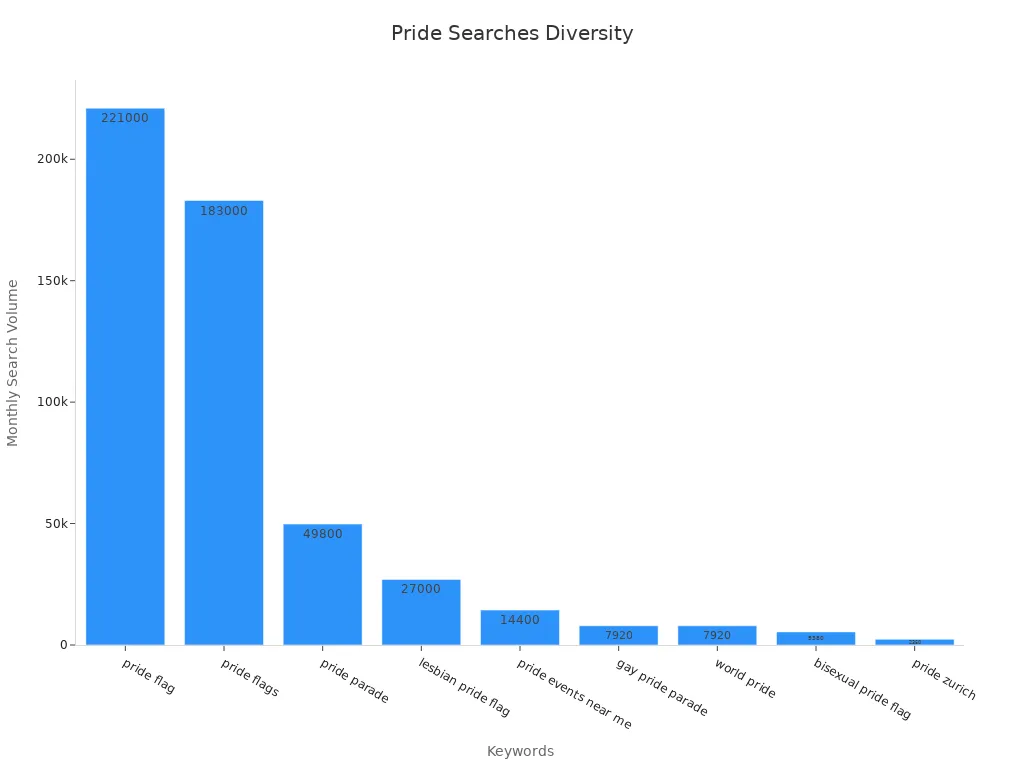
You’ll find all kinds of celebrations, from São Paulo’s massive parade to Singapore’s unique Pink Dot event. Even Antarctica joins in with Polar Pride! No matter where you are, when you celebrate Pride Month, you join a global movement for love, diversity, and acceptance.
Key Takeaways
- Pride Month began in 1969 with the Stonewall Riots and honors the fight for LGBTQ+ rights and equality.
- People worldwide celebrate Pride with parades, festivals, community events, and activism to show support and build inclusion.
- Supporting LGBTQ+ creators, businesses, and learning about LGBTQ+ history helps strengthen the Pride movement.
- Pride celebrations vary by region but share a common goal: to promote love, diversity, and acceptance.
- Many still face challenges, but grassroots efforts and global solidarity help create safer, more welcoming communities.
What Is Pride Month
Origins of Pride Month
You might wonder why people celebrate LGBTQ+ Pride Month every June. The story starts in New York City in 1969. On June 28, police raided the Stonewall Inn, a bar where many LGBTQ+ people gathered. Instead of staying silent, people stood up and protested. This event, called the Stonewall Riots, sparked a new movement for equal rights.
Here’s a quick timeline to help you see how LGBTQ+ Pride Month began:
- The Stonewall Riots happened on June 28, 1969, and changed the fight for LGBTQ+ rights.
- One year later, on June 28, 1970, the first Pride march took place to remember the riots.
- In 1978, artist Gilbert Baker created the rainbow flag, which became a symbol of pride and hope.
- In 1999, President Bill Clinton made June Gay and Lesbian Pride Month.
- In 2009, President Barack Obama expanded it to include the whole LGBTQ+ community.
- In 2016, the Stonewall Inn became a national monument.
Pride Month reminds you that the fight for equality started with brave people who refused to hide.
Global Spread of Pride
Today, LGBTQ+ Pride Month has grown into a global celebration. You can find parades, festivals, and community events in more than 100 countries. Some cities host huge parades, while others hold smaller gatherings or even celebrate online.
Pride Month matters because it gives people a chance to be seen and heard. Many people still feel invisible or left out. When you see rainbow flags, parades, or even Pride-themed products, it helps everyone feel included. Even small acts, like wearing a rainbow pin, can make a big difference.
LGBTQ+ Pride Month is not just about parties. It’s about standing up for rights, building community, and showing support. You help make the world more welcoming when you join in or show your support.
How People Celebrate Pride Month Globally
Parades and Festivals
When you think about LGBTQ+ Pride Month, you probably picture a parade. Parades are the heart of many pride celebrations. You see people marching, waving rainbow flags, and sharing messages of love and acceptance. Some cities, like New York and Sydney, host huge pride parades with floats, music, and costumes. In Amsterdam, the parade floats down the canals on decorated boats. Berlin’s Christopher Street Day Parade ends at the Brandenburg Gate, where the party continues into the night.
Here’s a quick look at how different places celebrate with parades and festivals:
| Location | Type of Celebration | Description |
|---|---|---|
| New York City, USA | Pride Parade and events | Iconic parade with activities supporting LGBTQ+ rights. |
| Amsterdam, Netherlands | Canal Parade | Boats on canals spread messages of love and acceptance. |
| Sydney, Australia | Mardi Gras Festival | Extravagant floats, costumes, and performances for equality. |
| Berlin, Germany | Christopher Street Day Parade | Parade and vibrant nightlife celebrations. |
| Tokyo, Japan | Rainbow Pride Parade and events | Parade, art shows, film screenings, and panel talks. |
| Cape Town, South Africa | Mother City Queer Project Parade | Annual pride celebration with a lively community and nightlife. |
| Manila, Philippines | Metro Manila Pride March | March for rights, gender identity, and HIV/AIDS awareness. |
You don’t have to travel far to join in. Many cities and towns hold their own pride celebrations, even if they are smaller. In the Triangle region of the U.S., you can find family-friendly events, brunches, book readings, and festivals like Out! Raleigh Pride. These events bring together people of all ages and backgrounds.
Pride parades and festivals let you celebrate pride month in your own way, whether you join a crowd or watch online. Google even helps you find events, LGBTQ+-friendly businesses, and digital art shows, so you can take part from anywhere.
Community Events and Activism
Pride celebrations are not just about parties. You can join community events that focus on activism and support. Many groups organize rallies, workshops, and volunteer days during LGBTQ+ Pride Month. These events help raise awareness about important issues like discrimination, health, and equal rights.
You might see local organizations hosting panel discussions, movie nights, or art exhibits. Some communities hold candlelight vigils to remember those lost to violence or illness. Others run fundraisers to support LGBTQ+ youth or health programs. When you take part in these events, you help build a stronger, more welcoming community.
You can also find digital ways to get involved. Google offers real-time navigation for parades and highlights LGBTQ+-friendly places. You can listen to curated playlists, join online games, or explore digital art. These tools make it easy for you to celebrate, even if you can’t attend in person.
Supporting LGBTQ+ Creators and Businesses
During LGBTQ+ Pride Month, you have a chance to support LGBTQ+ creators and small businesses. Many people choose to shop at LGBTQ+-owned stores, buy art, or eat at queer-friendly restaurants. This support helps these businesses grow and thrive.
Companies around the world now sponsor pride celebrations. InterPride reports that sponsorship revenue for pride organizations grew by 40% in 2023. Many groups work hard to make sure sponsors share LGBTQ+ values and support the community all year, not just during pride month celebrations. Sometimes, companies face criticism for “rainbow-washing,” but many are learning to build real partnerships that help fund community projects and education.
You might notice more pride-themed products in stores. A recent survey found that while some people see these as marketing, many LGBTQ+ shoppers prefer to buy from companies that show real support. When you choose to support LGBTQ+ creators and businesses, you help make pride celebrations more meaningful.
- You can:
- Buy from LGBTQ+-owned shops
- Support queer artists and musicians
- Eat at LGBTQ+-friendly cafes
- Share and promote LGBTQ+ creators online
Learning and Advocacy
Pride celebrations also give you a chance to learn and become a better ally. Many events include workshops, talks, and educational resources. You can attend a panel about LGBTQ+ history, join a book club, or watch a documentary. Google Arts & Culture offers digital exhibits and stories about LGBTQ+ icons and movements.
Learning helps you understand the struggles and victories of the LGBTQ+ community. It also shows you how to stand up for others. When you speak out against discrimination or support equal rights, you become part of the movement.
Tip: Even small actions matter. Wear a rainbow pin, share a story, or talk to friends about LGBTQ+ Pride Month. Every voice helps make pride celebrations stronger.
You can celebrate pride month in many ways. Whether you march in a parade, support a local artist, or learn something new, you help make the world more inclusive. Pride celebrations remind you that everyone deserves to feel proud and accepted.
Pride Month in North America
United States Parades and Events
You see some of the world’s biggest pride parades and events in the United States. Every June, cities like New York, San Francisco, and Chicago fill their streets with rainbow flags, music, and cheering crowds. You might join a parade, watch a drag show, or visit a pride festival in your own town. In 2022 and 2023, the country saw monthly peaks of over 600 pro-LGBTQ+ events, including parades, marches, and festivals. This number is much higher than the monthly count of anti-LGBTQ+ protests, which never went above 175. These numbers show just how many people come together to celebrate, support, and stand up for LGBTQ+ rights. You can feel the energy and excitement when you join a pride parade or attend a local celebration.
Canada Pride Season
Canada celebrates pride in a special way. June is not only Pride Month but also National Indigenous History Month. You learn about the deep roots of pride celebrations in Indigenous communities, where Two-Spirit people have always played important roles as healers and visionaries. Pride celebrations in Canada bring together people from many backgrounds. LGBTQIA+ people of color often face extra challenges, so pride events here focus on inclusion and intersectionality. Even small towns take pride seriously. One town was found guilty of human rights violations for refusing to declare June as Pride Month and fly the pride flag. This shows how important pride celebrations are for building community and showing support across the country.
Mexico City Marcha del Orgullo
Mexico City hosts one of the largest pride parades in Latin America. The Marcha del Orgullo draws over a million people every year. You see a sea of rainbow flags, music, and dancing as the parade moves through the city. Zona Rosa, the city’s LGBTQ+ district, comes alive with more than 50 gay bars and clubs. Even though public displays of affection can be taboo in other parts of Mexico, you find a strong and joyful LGBTQ+ community here. The pride parade in Mexico City gives people a chance to be visible, celebrate, and connect. This event makes the city a top pride destination in Latin America and helps everyone feel proud of who they are.
Pride in Europe
London Pride
You can feel the excitement in London every summer when the city bursts into color for pride. London Pride brings together thousands of people who march, dance, and celebrate in the heart of the city. You might see floats, drag performers, and families waving rainbow flags. The parade usually ends in Trafalgar Square, where you can enjoy live music and speeches. London’s pride celebrations also include art shows, film screenings, and workshops. You get a real sense of community and support here.
Berlin Christopher Street Day
Berlin’s Christopher Street Day stands out as one of Europe’s most important pride events. You walk through the city and notice how deep the LGBTQ+ roots go. In 1983, Christian Pulz organized the first public LGBT demonstration in East Germany, marking a turning point for activism. Berlin’s Schöneberg district, known as the city’s gayborhood, hosts not only Christopher Street Day but also the Lesbian and Gay City Festival and Folsom Europe. The city’s LGBTQ+ culture stretches back about 180 years, making Berlin a true center for queer life and pride in Europe.
Berlin’s pride parade honors both history and progress. When you join the celebrations, you become part of a tradition that remembers the past and looks to the future.
Madrid Orgullo
Madrid Orgullo, or Madrid Pride, might be the biggest and most lively pride event in Europe. You find the city buzzing for over a week with concerts, races, art shows, and even a human rights conference. The parade itself draws around 2 million people, filling the streets with music and joy. Madrid Orgullo shows you how pride can bring a whole city together for fun, learning, and activism.
Amsterdam Pride
Amsterdam Pride gives you a unique experience with its famous Canal Parade. Over 80 boats, covered in glitter and rainbows, float through the city’s canals. You see crowds cheering from the bridges and along the water. The Homomonument, inspired by the pink triangle, stands as a reminder of the city’s long fight for LGBTQ rights. Amsterdam’s pride celebrations highlight the city’s role as a leader in acceptance and freedom.
Tip: If you ever visit Europe in the summer, try to catch one of these pride celebrations. You’ll see how each city adds its own style and spirit.
LGBTQ+ Pride Month in Latin America
São Paulo Pride Parade
If you want to see one of the world’s biggest pride events, you should visit São Paulo. Every year, millions of people fill the streets for the São Paulo Pride Parade. You can hear music, see colorful costumes, and feel the energy from the crowd. The parade stretches down Avenida Paulista, which is the city’s main street. People from all over Brazil and even other countries come to join the fun. You might spot huge floats, dancers, and families waving rainbow flags. This parade started in 1997 and has grown every year. Now, it stands as a symbol of hope and freedom for many in Latin America.
Buenos Aires Pride
Buenos Aires knows how to celebrate pride too. You can join thousands of people as they march through the city, singing and dancing. The city’s pride event, called Marcha del Orgullo, happens every November. Argentina leads the way in LGBTQ+ rights in Latin America. In 2010, the country became the tenth in the world to legalize same-sex marriage. Two years later, the Gender Identity Law made it easier for people to change their gender on official documents. In 2021, a new law created more jobs for trans people in government. These changes show how pride in Buenos Aires is about more than just a parade. You see real progress and growing acceptance. Big companies, like Sprite, even join the celebrations to show support. When you walk in Buenos Aires Pride, you feel part of a movement that keeps growing stronger.
Montevideo Pride
Montevideo, the capital of Uruguay, also shines during pride month. You can join the city’s pride march, which brings together people of all ages. The streets fill with music, laughter, and rainbow colors. Uruguay was one of the first countries in South America to allow same-sex marriage. The pride celebrations here feel welcoming and joyful. You might see art displays, concerts, and even family picnics. Montevideo’s pride events help everyone feel safe and proud to be themselves.
Tip: If you ever travel to Latin America, try to join one of these pride celebrations. You will see how each city brings its own style and spirit to the movement.
Pride Month in Asia
Asia’s pride celebrations keep growing every year. You see more cities joining in, and the events get bigger and brighter. Let’s look at how people in Tokyo, Taiwan, and India mark pride month.
Tokyo Rainbow Pride
You feel the energy at Tokyo Rainbow Pride. The event fills Yoyogi Park with music, food stalls, and colorful costumes. Many famous Japanese celebrities join the parade, which helps make it a big deal in Japan. You might spot singers, actors, and TV personalities showing their support. Their presence brings more attention to LGBTQ+ rights and helps everyone feel welcome.
- You see performances from well-known artists.
- The parade features creative signs and rainbow outfits.
- Tokyo Rainbow Pride stands out as a key event in East Asia, inspiring other countries to celebrate.
This event started small but now draws huge crowds. It shows you how pride can bring people together, even in places where being LGBTQ+ is still hard.
Taiwan Pride
Taiwan hosts the largest pride parade in East Asia. You walk through Taipei and see thousands of people waving rainbow flags. Taiwan became the first place in Asia to legalize same-sex marriage. That makes pride here extra special. The parade includes music, speeches, and lots of dancing. You notice families, friends, and even tourists joining the fun. Taiwan Pride shows you what acceptance looks like in action.
India Pride Marches
India’s pride marches fill the streets with color and hope. You might join a march in Delhi, Mumbai, or Bangalore. Each city adds its own style. People carry banners, wear bright clothes, and dance to music. After the Supreme Court decriminalized homosexuality in 2018, more people started joining pride events. You see students, families, and activists walking together. These marches help people feel proud and safe.
Here’s a quick look at how pride is expanding in Asia, especially in Thailand:
| Indicator | Numerical Value | Description |
|---|---|---|
| Number of Pride Parades nationwide | 19 locations | More cities now host pride events. |
| Total visitors during celebrations | >1.3 million | Shows how many people join in. |
| Participants in Bangkok Pride Festival 2025 | >300,000 people | Big crowds gather for the main parade. |
| Length of Bangkok Pride Parade route | 3 kilometers | The parade covers many city landmarks. |
| Number of partners involved | >70 partners | Many groups support the events. |
Tip: If you ever visit Asia during pride month, check out a local parade. You’ll see how each country celebrates in its own way.
Pride in Africa
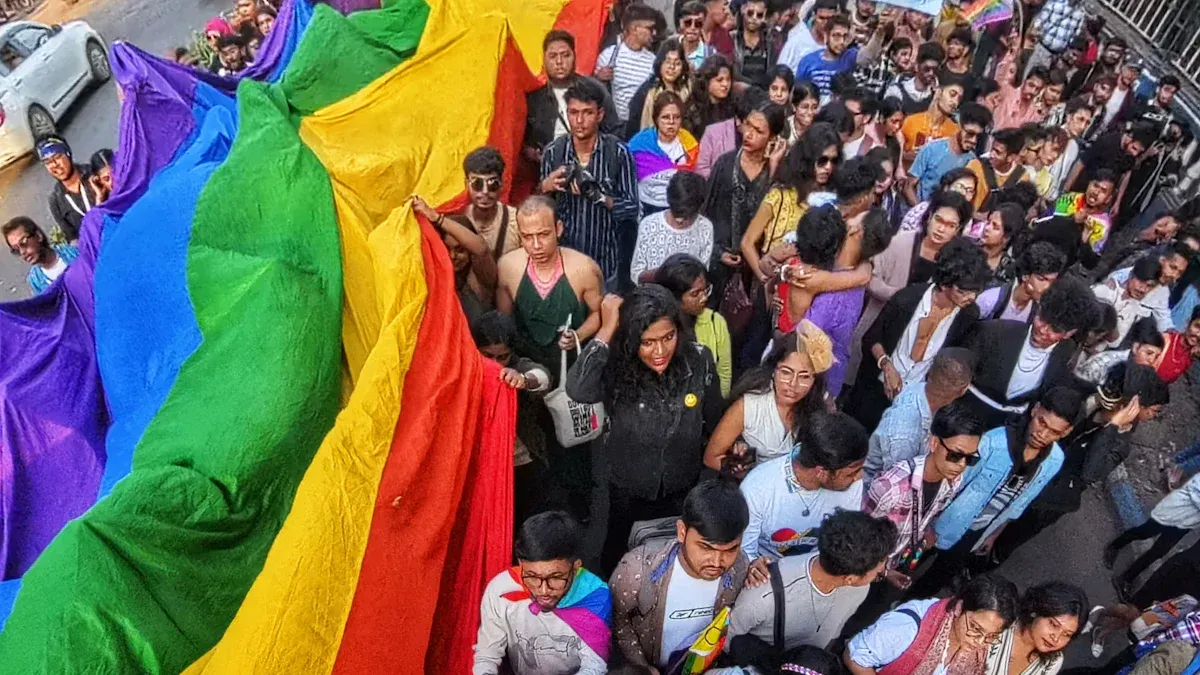
Cape Town Pride
You can feel the energy of Cape Town Pride every year. This event started with South Africa’s first gay and lesbian pride parade in 1990. Simon Nkoli and Beverley Ditsie organized it, making history as the first event of its kind on the African continent. When you join Cape Town Pride, you walk in the footsteps of activists who fought for both LGBTQ+ rights and freedom from apartheid. Simon Nkoli showed everyone that the fight for equality covers both race and sexual orientation.
Here are some ways Cape Town Pride has made a difference:
- The activism around this event helped add sexual orientation to South Africa’s 1996 constitution as a protected right.
- Court cases like Gory v Kolver gave more legal rights to same-sex couples.
- Leaders like Desmond Tutu spoke out for LGBTQ+ rights and challenged homophobia.
- Early pride events in Cape Town set a standard for human rights across Africa.
You see people from all backgrounds coming together. The parade, music, and art make you feel welcome and proud.
Johannesburg Pride
Johannesburg Pride is the oldest pride event in Africa. You find it in the heart of South Africa’s biggest city. The first parade took place in 1990, just like Cape Town. Today, you see thousands of people marching, dancing, and waving rainbow flags. Johannesburg Pride stands out because it mixes celebration with activism. You might join a march for equal rights or attend a workshop about health and safety. The event brings hope to many people who still face challenges in their daily lives.
Emerging Pride Movements
You notice new pride movements growing in other African countries. In places like Kenya, Uganda, and Botswana, people organize smaller events, sometimes in secret. These gatherings show courage and hope. Even when laws make it hard, you see activists finding ways to celebrate and support each other. Social media helps connect people and spread messages of love and acceptance. Each year, more cities join the movement, making Africa’s pride celebrations stronger.
Tip: If you want to support pride in Africa, you can follow local organizations online or share their stories. Every voice helps build a safer and more welcoming world.
Pride Month in Oceania
Sydney Mardi Gras
You might feel amazed when you see Sydney Mardi Gras. This event is not just a parade. It is a huge festival that lights up the whole city. Every year, you find people from all over the world coming to join the fun. In 2019, about 500,000 people watched the parade. Over 16,000 people marched in it. You can see bright costumes, big floats, and lots of dancing. The Fair Day event also draws huge crowds, with 80,000 people enjoying music, food, and games.
Here’s a quick look at some numbers that show how big Sydney Mardi Gras is:
| Statistic/Event | Data/Description |
|---|---|
| Parade Attendance (2019) | 500,000 spectators |
| Fair Day Attendance (2019) | 80,000 spectators |
| Participants in Parade (2019) | 16,500 |
| Party Participants (2019) | 13,626 |
| Economic Impact (Annual) | A$30 million for New South Wales |
| Regional Significance | Largest Pride event in Oceania |
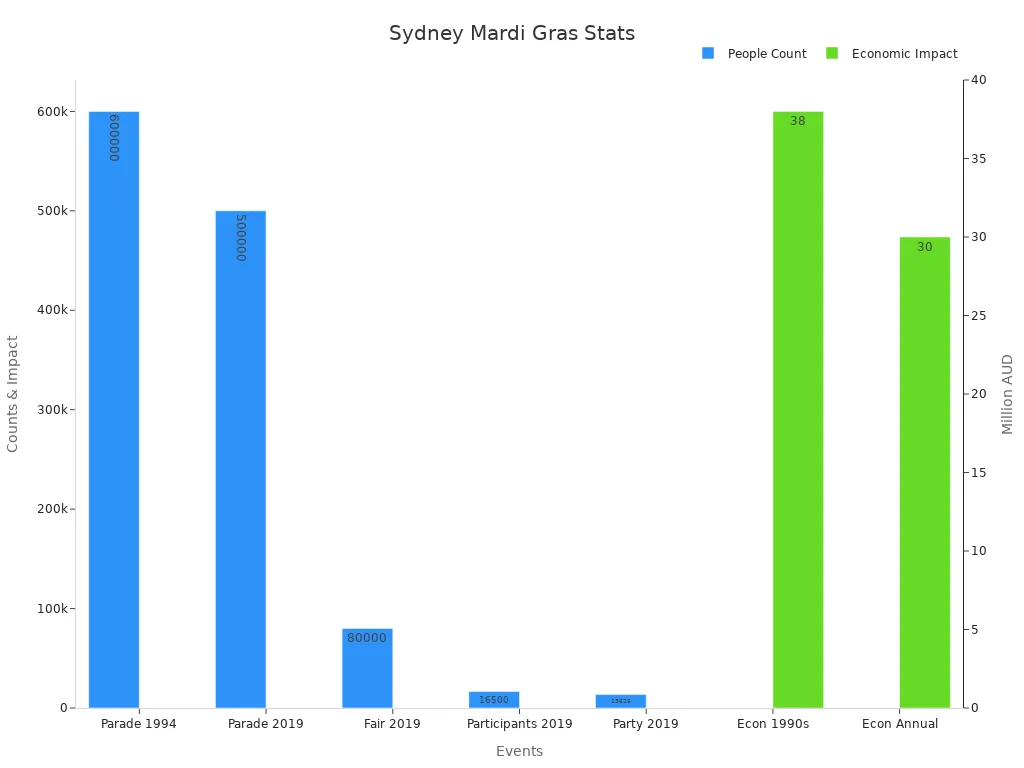
You might hear people call Sydney Mardi Gras the biggest pride event in Oceania. It even hosted WorldPride in 2023, the first time this happened in the Southern Hemisphere. The festival brings in tourists and helps the local economy. You see people of all ages and backgrounds coming together to celebrate love and acceptance.
Tip: If you ever visit Sydney during Mardi Gras, you can join the parade or watch the amazing shows. You will feel the energy and joy everywhere.
Auckland Pride
Auckland Pride gives you a different but just as exciting experience. The city fills with color and music every February. You can join the Pride March, which moves through the heart of Auckland. People carry banners, wear rainbow outfits, and dance in the streets. The festival also has art shows, movie nights, and talks about LGBTQ+ rights.
You might notice that Auckland Pride focuses on making everyone feel welcome. The events include family picnics, youth gatherings, and even sports games. Organizers work hard to include Māori and Pacific Islander voices, so you learn about many cultures. The festival helps people feel proud of who they are and builds a strong community.
Note: Auckland Pride keeps growing every year. You see more people joining in, and the city becomes brighter and more open.
Pride in the Middle East
Tel Aviv Pride
You might feel surprised to learn that Tel Aviv hosts one of the largest Pride events in the Middle East. Every summer, the city bursts with color, music, and excitement. People travel from all over the world to join the celebration. Tel Aviv is often called the LGBTQ capital of the region. You see rainbow flags everywhere, and the city feels alive with energy.
Here’s a quick look at what makes Tel Aviv Pride so special:
| Evidence Type | Details |
|---|---|
| Attendance Figures | 170,000 in 2022; 250,000 in 2019; 100,000 in 2021; 200,000+ in 2023 |
| LGBTQ Population Estimate | Nearly 100,000 people in Tel Aviv identify as LGBTQ |
| Event Duration | Pride has been held for over 23 years |
| Official Support | Mayor Ron Huldai and Social Equality Minister Meirav Cohen actively support the event |
| International Recognition | U.S. Ambassador to Israel attended, emphasizing tolerance and respect |
| Regional Significance | Tel Aviv is often called the LGBTQ capital of the Middle East |
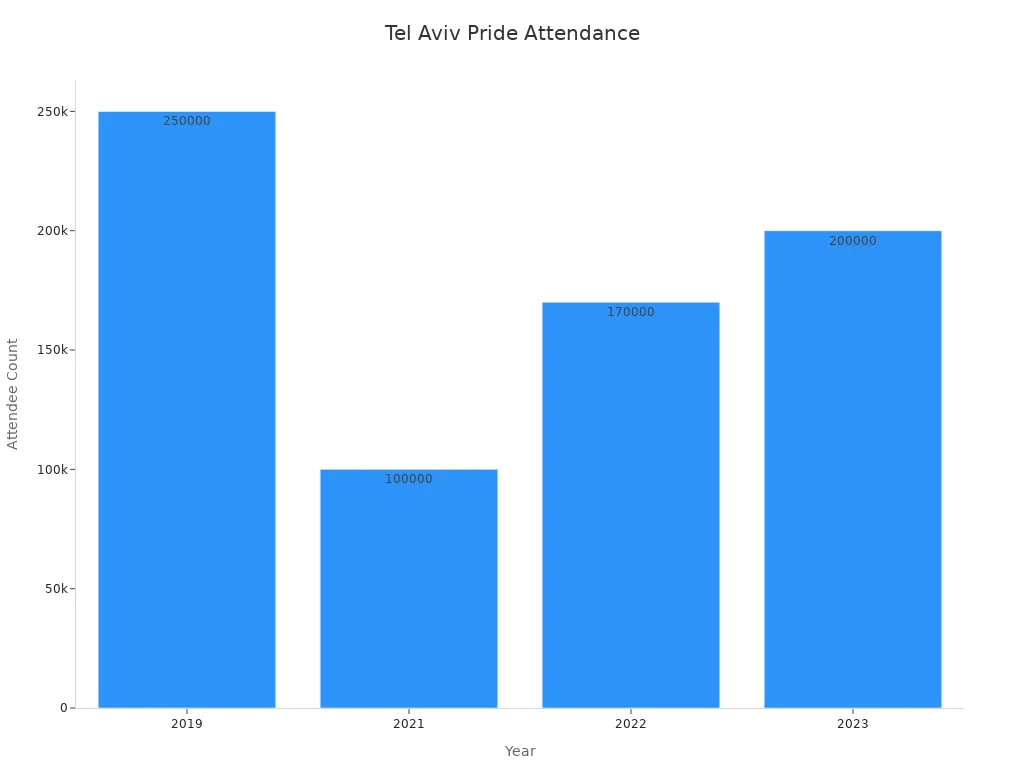
In 2023, over 200,000 people joined the Tel Aviv-Jaffa Pride events. The parade itself had 150,000 marchers. You might spot the mayor and other leaders walking at the front, showing their support. Officials talk about equality, human rights, and the freedom to love without fear. You feel the sense of community and hope all around you.
Tip: If you ever visit Tel Aviv during Pride, you can join the parade, dance at the beach parties, or just enjoy the joyful atmosphere.
Online and Discreet Celebrations
Not every city in the Middle East can host big parades. Many LGBTQ+ people here face tough challenges. You might notice that most people keep their identities private. Some even wear masks at Pride events to stay safe.
- Surveys show that over 80% of people in many Middle Eastern countries reject homosexuality as acceptable.
- Public acceptance rates are very low, sometimes less than 10%.
- LGBTQ+ groups like Rainbow Street and OutRight Action International help people find safe spaces and support.
You see that online spaces become lifelines for many. People join secret groups, share stories, and find friends who understand. Sometimes, you spot small acts of pride, like a rainbow flag at a protest or a quiet gathering in someone’s home. These moments matter. They help people feel seen, even when it’s risky.
Scholars say that online and discreet Pride celebrations help LGBTQ+ people stay visible and connected. Activists use creative ways to show pride, even in hard times. You learn that every small act of courage counts. In the Middle East, Pride often means finding hope and community in quiet, powerful ways.
Challenges and Progress
Legal and Social Barriers
You might think Pride Month is all about celebration, but many people still face tough challenges. In fact, about one-third of countries around the world still have laws that make same-sex relationships illegal. Some places even limit what you can say or do if you are LGBTQ+. These rules make it hard for people to live openly and safely.
You also see social barriers every day. Many LGBTQ+ people deal with discrimination at work, in school, or when they try to rent a home. Some even avoid going to the doctor because they fear unfair treatment. Studies show that nearly 25% of LGBTQ+ people have seen discrimination from healthcare staff, and 1 in 7 avoid medical care because of this fear. Young people feel these struggles too. About half of LGBTQ+ youth experience depression, and 1 in 8 have tried to end their own lives. These numbers show why Pride Month is still so important.
Note: You help break down these barriers when you speak up, support friends, or learn more about LGBTQ+ rights.
Grassroots Movements
You see real change start with everyday people. Grassroots movements bring hope to communities, even in places with strict laws. Local groups organize safe spaces, support networks, and small events. Sometimes, these gatherings happen in secret, but they still make a big difference.
Here are some ways grassroots groups help:
- Offer mental health support and counseling
- Create safe places for LGBTQ+ youth
- Teach people about rights and acceptance
- Share stories online to reach more people
You can join these efforts by volunteering, sharing resources, or just being a good friend. Every small action counts.
Global Solidarity
You are part of a worldwide movement when you celebrate Pride Month. People in different countries connect through social media, art, and activism. They share ideas, support each other, and stand up for those who cannot march openly.
| How You Can Show Solidarity | Example Actions |
|---|---|
| Learn about global issues | Read stories from other countries |
| Support online campaigns | Share posts or donate |
| Celebrate diversity | Join local or virtual events |
Remember: When you show support, you help build a kinder, more equal world for everyone. 🌈
You see how pride month brings people together in so many creative ways. Around the world, you find parades, art, and new friendships. Still, some places face tough rules, safety worries, and unfair treatment. Many groups work hard to make things better, like starting LGBTQ+ clubs or joining local events. When you learn, show support, or stand with others, you help build a future where everyone feels proud and safe. 🌈
FAQ
What does the rainbow flag mean during Pride Month?
You see the rainbow flag everywhere during Pride Month. Each color stands for something special, like life, healing, and hope. The flag shows support for LGBTQ+ people and reminds everyone to celebrate diversity.
Can you join Pride events if you are not LGBTQ+?
Yes! You can join as an ally. Pride welcomes everyone who supports love and equality. When you show up, you help make the community stronger and more inclusive.
How can you support Pride if you cannot attend a parade?
You can:
- Share positive messages online
- Support LGBTQ+ businesses
- Learn more about LGBTQ+ history Every small action helps!
Why do some places celebrate Pride at different times?
Some cities pick different months because of local weather, holidays, or history. For example, Sydney celebrates in February. You can find Pride events almost any time of year around the world.





